Are you thinking of hiking to the top of Mount Ijen? As one of Indonesia’s most unique volcanoes, it sees a lot of visitors, but a hike to the summit is not without its dangers. Learn everything you need to know about Indonesia’s Mount Ijen Volcano in this complete hiking guide.
Mount Ijen, or Kawah Ijen, is a natural wonder which attracts hikers and nature fanatics due to its unique “blue fire” phenomenon. You might have already read about this, but if not, it’s caused by the combustion of sulfuric gases escaping from the volcano’s vent.
As the sulfuric gases rise and come into contact with the oxygen-rich air, they ignite and produce a mesmerizing blue flame along the surface of a sulfuric lake within the crater.
It’s a unique natural occurrence not to be missed, so of course, it rained when we visited, and we missed it! Nevertheless, the views from the summit are truly captivating. They will make any visit to Mount Ijen worthwhile, blue fire or not!
About Ijen National Park
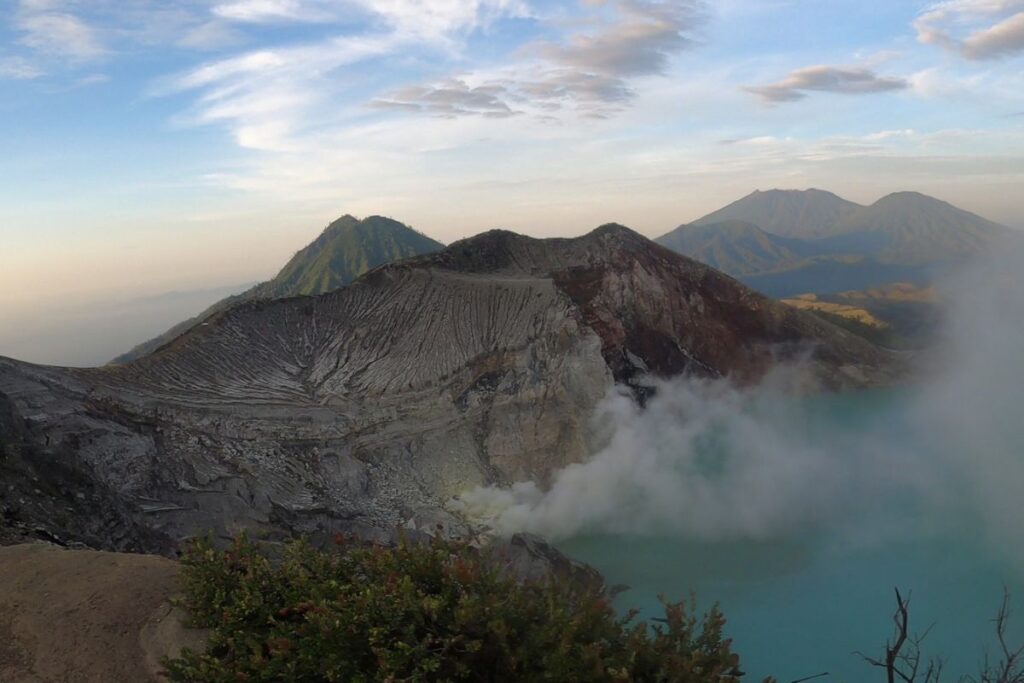
Mount Ijen National Park is a magnificent natural treasure located in East Java, Indonesia. The park spans over 190 square kilometers and is renowned for its stunning landscapes, diverse ecosystems, and the majestic Mount Ijen volcano.
The Park is an absolute gem for nature enthusiasts like us. It offers a unique and unforgettable experience, combining breathtaking scenery with a fascinating geological phenomenon.
With its breathtaking landscape, lush greenery, mountainous terrain, and serene turquoise crater lake, climbing to the summit of Mount Ijen is an absolute must!
We were left in absolute wonderment by the end of the trip. From the moment the sun came up, we could see out over the horizon and were captivated by the volcano and the park’s awe-inspiring beauty!
Apart from the volcanic wonders, Mount Ijen National Park is also home to rich biodiversity and protected ecosystems. The park is home to many endemic species and teeming with a wide array of wildlife. Unfortunately, we didn’t get to explore further into the park ourselves, but it’s on the list for when we return!
If you’re into bird watching, it’s a fantastic place to visit with the opportunity to spot rare and colorful bird species. Nature enthusiasts can explore the park’s trails, which will take you to hidden waterfalls and panoramic viewpoints.
The local communities surrounding Mount Ijen add to the cultural richness of the area. Many locals work as sulfur miners, braving the hazardous conditions of the crater to extract sulfur, which is used for various industrial purposes.
Sulfuric Mining on Mount Ijen

Picture a group of determined individuals venturing into the depths of the volcano’s treacherous crater, armed with only grit and perseverance. These sulfur miners brave the toxic fumes and perilous conditions to extract sulfur every day, usually without gas masks.
Often, local men from the surrounding villages descend into the crater armed with minimal equipment and protection. Where they should be wearing gas masks, most do not; whether this is because it impacts their ability to work or they don’t own one, I’m not sure.
Sulfur mining on Mount Ijen is not for the faint-hearted. It’s a testament to the resilience and indomitable spirit of the local community. These miners endure backbreaking labor and inhale toxic fumes to make a living.
They will earn around $10 -$15 a day, which is considered a highly-paid wage for the area. However, they are risking their lives, and many of them will have a shorter life expectancy.
I felt a mix of emotions when I saw these miners at work. It was astonishment, sadness, and admiration. For those who have lost their lives mining sulfur at Mount Ijen, their stories are etched into the rugged landscape of this volcanic wonder forever.
Mount Ijen Crater & Blue Fire
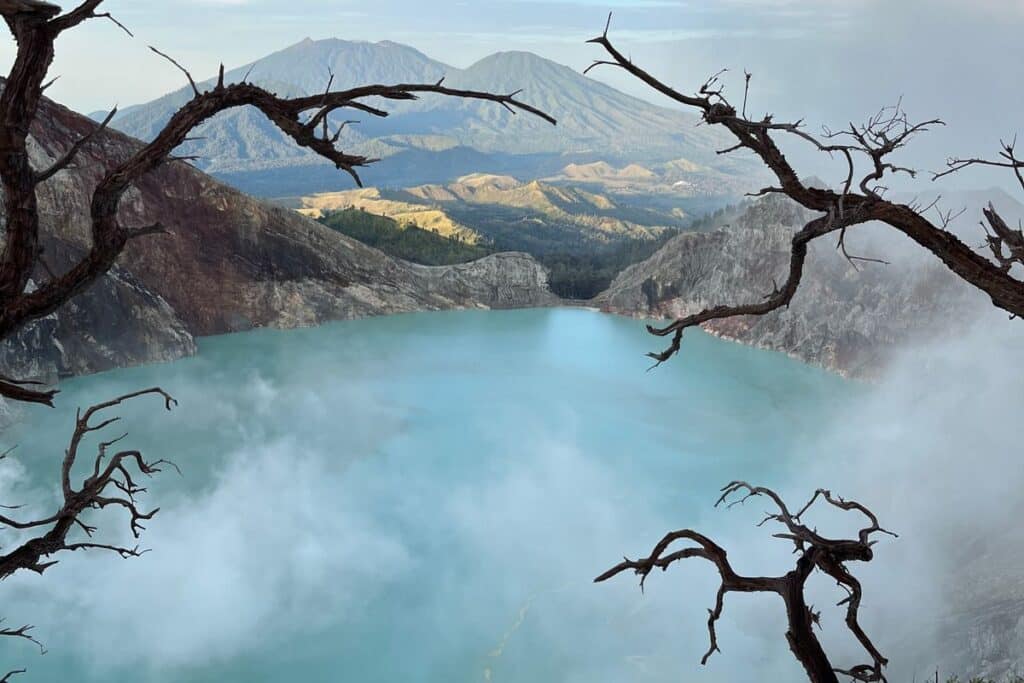
The true reason most people visit Mount Ijen volcano is for its stunning turquoise crater lake and blue fire. This crater is one of the world’s largest acidic crater lakes and is surrounded by rugged volcanic peaks.
The most remarkable feature of Mount Ijen is the blue fire phenomenon. Underneath the cover of darkness, the ignited sulfuric gases create an ethereal blue glow, illuminating the volcanic landscape.
This natural spectacle is incredibly rare, with only a few other locations in the world where it can be seen.
We were completely gutted that we couldn’t witness it ourselves. However, once the sun came up, the views made up for our disappointment.
Where Is Mount Ijen Volcano

Mount Ijen volcano lies at the heart of Ijen National Park in East Java. This bad boy stands tall, ready to showcase its breathtaking beauty to all who dare to venture near.
If you’re up for an adventure, head on over to Ijen National Park and prepare to have your mind blown by the mighty Mount Ijen Volcano!
Overview: Mount Ijen Volcano Sunrise Trek

Difficulty Level: Intermediate
Time: est. 1 am to 7 am
Cost: IDR 100.000 pp (weekday) / IDR 150,000 pp (on the weekend)
When planning a hike to the summit of Mount Ijen, you’ll need to consider a few things.
- How you’ll be visiting Mount Ijen, whether on a guided or self-guided tour.
- Consideration for what to wear and what to pack is important; remember you’ll be hiking through the night.
- You’ll need to ensure you know how to get to the park entrance and where you will stay during your visit.
- Something else to keep in mind is the weather will determine if you’ll get to see the blue fire, and this will determine if you’ll need to rent a gas mask or not. In the end, we didn’t need the masks as we didn’t go down into the crater.
Luckily, I’ve put all this information together for you in this complete hiking guide to Mount Ijen, ensuring you know exactly what to expect from your trip!
Gas Masks and Tickets

Mount Ijen is renowned for its potentially hazardous sulfuric gas emissions. So, if you’re going down into the crater, it’s important you strap on a reliable gas mask. You can organize gas masks at the entrance when purchasing tickets.
As for the tickets, it’s best to have them sorted in advance, especially during peak season. That said, we bought them upon arrival without any issues, but this was during the low season.
The “Ijen Taxi” Service

Something we found rather amusing was the Ijen taxis. This unique transportation option offers a not-so-comfortable ride up or down the mountain. I guess it’s for those of your who are feeling tired or have possibly incurred an injury.
Numerous locals will approach you throughout the hike, offering up their taxi service, which is, more aptly, a cart/trolley turned into a makeshift taxi. It certainly didn’t look safe, but they seemed to whizz around with ease, managing to keep their passengers upright!
Honestly, it looked quite fun but wasn’t for us. It’s also impossible to go all the way to the summit as the trail transforms into a winding rocky path toward the top.
What to Pack for Climbing Mount Ijen
To make the most of your visit, it’s important to go prepared. This means packing a small bag with some essentials, including:
- water
- a packed lunch
- a windproof jacket
- hats & gloves
- a headlamp
- a camera.
It was cold at night, and we wore walking trousers, a fleece, and a lightweight jacket. However, it does warm up after you get the blood pumping, so you’ll likely end up removing some layers.
Tip: Put shorts under your walking trousers so you can easily remove them! You’ll also end up putting them back on when you reach the summit. I put my trousers on over my shorts while we waited for sunrise.
It’s not essential to wear hiking boots; this trek can be done in trainers, but make sure they have a good grip. That said, investing in a good pair of hiking boots with a good grip will make it a much easier hike!
If you have issues with your knees or back, investing in a lightweight, packable hiking pole will help. The way down is steep and can get slippery, so you’ll want to be careful.
It’s essential you pack fresh water and some food. It’s surprising how dehydrated this hike makes you, and there’s nothing worse than running out of water. So be generous and kind to yourself.
Where to Stay Near Ijen, National Park
Are you visiting Mount Ijen without a guide? If so, booking a hotel that offers transport services to the entrance is a good idea. Since this is normally included within a tour package, it might determine which hotel you choose to stay at during your visit.
The Mount Ijen Sunrise Hike: What to Expect
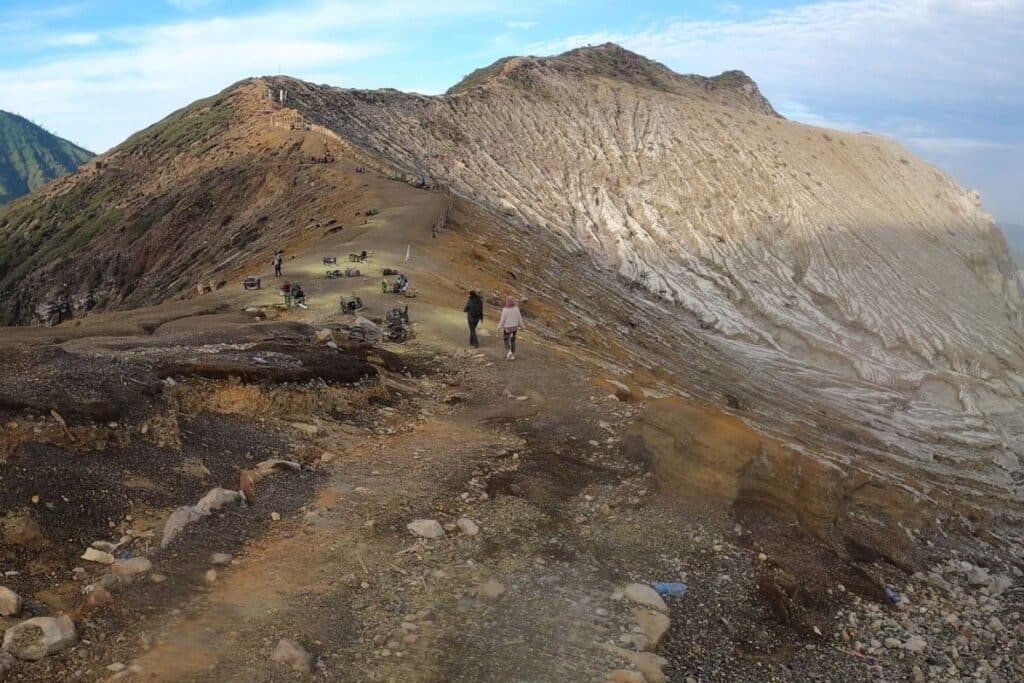
It was an ethereal atmosphere, coupled with the warmth of friends while witnessing the sunrise over the breathtaking panorama of the park was a sight that will stay with me forever, and I’m grateful for the sheer beauty that exists in our world.
Our Journey to Ijen National Park
A joyous yet unexpected part of this trip was, in fact, the journey over to Java. We left Bali on our scooters the day before our hike and crossed into Java via Gilimanuk port. It was a quick 30-minute crossing which passed trouble-free.
It was easy enough to cross into Java as plenty of vendors sell tickets along the road leading to the port in Bali. [If you’re interested in a full transportation guide, here’s how to get to Mount Ijen from Bali – the complete guide]
The ride was beautiful, which made the trip even more memorable. We traveled along mountain roads and through the jungle, passing stunning views.
If you decide to spend additional time in Ijen, there are some interesting places to explore, including the rural villages, endless rice fields, and Jagir Waterfall.
What Time to Start the Hike
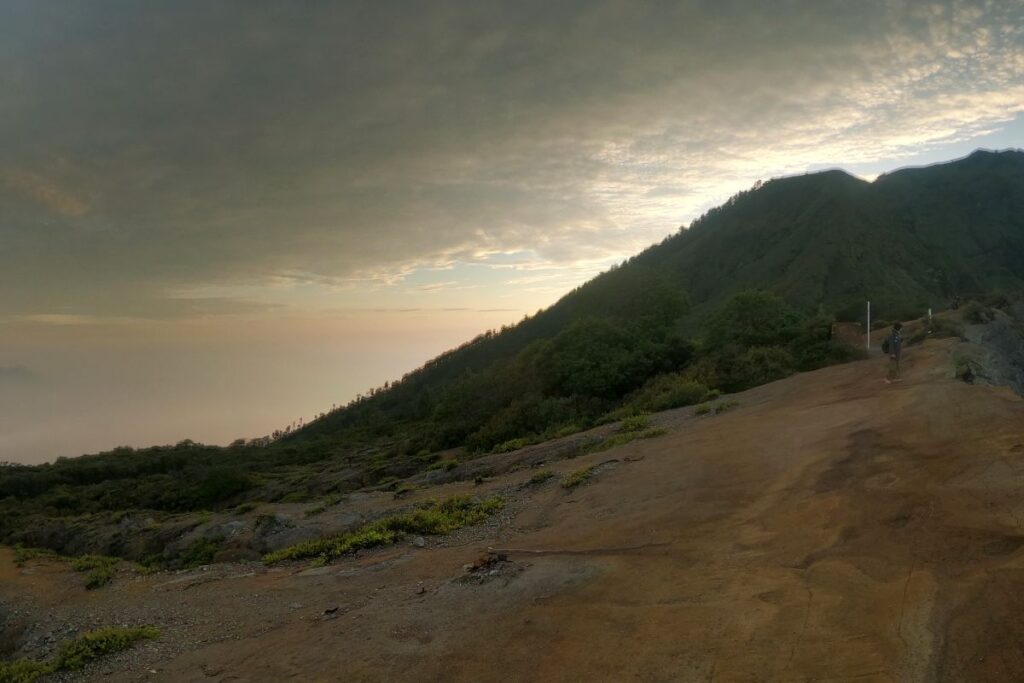
When it was time for our hike, we were up at 1:30 am. We arranged car transportation with some friends coming directly from Bali to pick us up. Even so, it still took us 1 hour to reach the hike entrance.
Since we visited during the low season there we no queues to get our tickets, but I would advise purchasing these in advance or arriving earlier (12 to 1:30 am) to ensure you reach the top in time for sunrise.
At the entrance to the trail, there is a large car park and numerous shops. You can purchase headlamps, gloves, hats, and snacks as they will be open. There are also many street vendors selling these same products who will approach you on arrival.
It’s possible to arrange a guide at this point. You can negotiate the price or decline depending on your preference (more on Mount Ijen guides & prices below).
We started hiking around 2:45 am, which by all accounts is a little later than recommended. There are a few things to consider when deciding what time to begin.
Since it had been raining, we knew we wouldn’t get to see the blue fire, so we wouldn’t be going into the crater. If you are hoping to do this, I suggest beginning your hike at 1:30 am to ensure you have enough time to get into the crater and back up for sunrise.
Expect long queues into the crater, and you will need a gas mask.
The Mount Ijen Hike
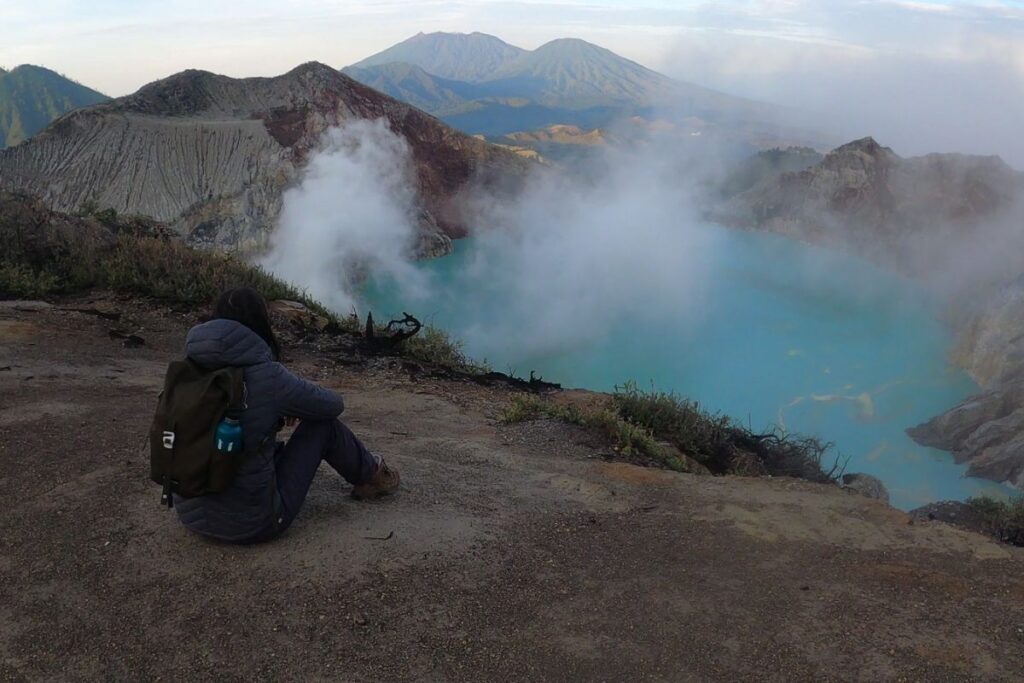
Trekking through the park’s rugged trail, you’ll encounter various terrains. It starts off on a tarmac path that isn’t too steep but gradually the steepness will gradually increase until the tarmac ends and a wild dirt trail begins.
It would be very difficult to get lost as there is only one main path to follow, surrounded by trees along the tarmac section and rock walls when you get higher.
We reached the top in two hours, which was just in time for sunrise, but to be sure we ran the last 300m with an excitable burst of energy. Sunrise was scheduled at 5:05 am!
Mount Ijen Sunrise Spot

Interestingly, the sunrise is behind a huge mountain which blocks part of the view. It doesn’t matter where you are along the crater’s rim, you won’t be able to avoid this, but you can escape the crowds that gather around the shelters at the “official” sunrise spot.
We ran along the rim, jumping over great big holes and cracks in the ground to reach an area we thought suitable to enjoy the view.
The sky was changing color before our eyes. It was a soft orange and yellow towards the horizon, slowly becoming a pastel pink with golden hues. The colors seemed to crawl into the sky above us.
Not long after the first rays started appearing, the sky was ablaze with a fantastic muddle of soft coral colors before becoming the brightest baby blue. Even the clouds were fantastic fluffy things!
The lake was a piercing turquoise, and with a wispy sulfur cloud, it felt almost unworldly.
The Views at Mount Ijen Volcano
You’ll witness breathtaking views, from an epic sunrise to breathtaking landscapes. The best way to immerse yourself is to explore the area away from the crowds.
Don’t be afraid to explore around the rim. There aren’t really any designated pathways, but that’s okay, make your own path. There are many interesting viewpoints, and with no one around, it’s perfect for photography.
You’ll get to see the crater from different perspectives and angles; just be cautious of the wind direction. The last thing you want is to get a puff of smoke in your face and lungs!
The Blue Fire & Crater Expedition
Although we didn’t go down into the crater, you might be interested in knowing what to expect from this. From what we’ve researched it seems to attract a large crowd so expect long queues of up to an hour.
Did you know Sulfur mining has been underway at Ijen Crater since 1968? To spend up the natural process of sulfur formation, the miners have installed ceramic pipes on active gas vents!
It’s best to have a guide if you plan to enter the crater as it can be quite dangerous, although it is unnecessary. It’s advised not to go down the crater if you have any breathing problems or are asthmatic.
The path leading down is quite narrow, and you’ll have to make room for the miners who regularly pass with their baskets full of “yellow gold”. You can take photos of the miners but they ask for a tip, something in the region of 15,000 IDR.
Mount Ijen Sunrise Hike Cost: Guided/Non-guided/Tour
Without a Guide
Note: This pricing excludes transportation to and from Ijen, the starting point is from your hotel accommodation.
Hotel Price (Mid-Range) 330,700 / $22
Transport (Booked Through Hotel) 500,000 / $33
Ticket Price (weekday/weekend)100,000 / 150,000 ($6.50 / $10)
Total (IdR/$): IDR 930,700 /$61.50
Add Ons: Gas Mask / Headlamp/ Snacks: 75,000 – 225,500 ($5- $15)
With a Guide
The prices will be the same as above, but if you want to hire a tour guide once you arrive at the entrance to Mount Ijen volcano, you’re looking at around 200,000 IDR ($15).
It’s a nice way to support the local community and gain some insights into the area. Your guide should be able to answer any questions you have about Ijen National Park and help you with your climb.
However, if you’re confident, you won’t need a guide, as the path is pretty straightforward.
Mount Ijen Hike Tours
The final way to visit Mount Ijen Volcano is to go on an arranged tour. There are various tours to choose from, but they will generally offer similar deals. Most will include transport to and from your accommodation to Mount Ijen, a tour guide, and gas masks.
Add-ons like snacks and clothing won’t be included.
Visitors Tips & What to Watch Out For
- Prepare for the Trek: If you’re not used to hiking, Mount Ijen’s ascent can be challenging, so it’s essential to be physically prepared.
- Bring Layers: Bring suitable hiking gear, including sturdy footwear, warm clothing, and a headlamp. It gets warmer after sunrise.
- Pack a Backpack: Pack a backpack with essentials like water, snacks, a packed lunch, and a gas mask. If you can, wrap your food in plastic to protect it from sulfur.
- Invest in Hiking Boots: If you can use hiking boots with good traction, trainers are okay, but they need grip. Hiking boots will help protect your ankles from twisting.
- Run Instead of Walking: On our return, we ran down the mountain as it was less stressful on our knees. A gentle jog is much easier than walking!
- Check Opening Times: The path is closed on the first Friday of every month, and if you want fewer crowds, plan to go on the weekday as weekends are busier.
- Start Early for the Sunrise: To witness the stunning sunrise over the crater lake, it’s crucial to start your hike early. Aim to begin the trek around midnight/1 am.
- Gas Masks are a Must: Mount Ijen emits sulfuric gases, which can be hazardous to inhale. Don’t forget to bring a reliable gas mask to protect yourself from the fumes if you’re going into the crater.
- Stay Safe and Follow Instructions: Mount Ijen’s terrain, with steep slopes and uneven surfaces, can be challenging. Stay on designated paths and follow the instructions of your guide or park officials.
- Respect the Environment and Local Community: Mount Ijen National Park is a precious natural ecosystem, and it’s crucial to treat it with respect. Avoid littering, stay on marked trails, and refrain from damaging any plant or animal life.
By following these visitors’ tips, you’ll be well-prepared to tackle the climb up Mount Ijen volcano while ensuring your safety, respecting the environment, and making the most of this extraordinary experience!
Indonesia’s Mount Ijen Volcano FAQ
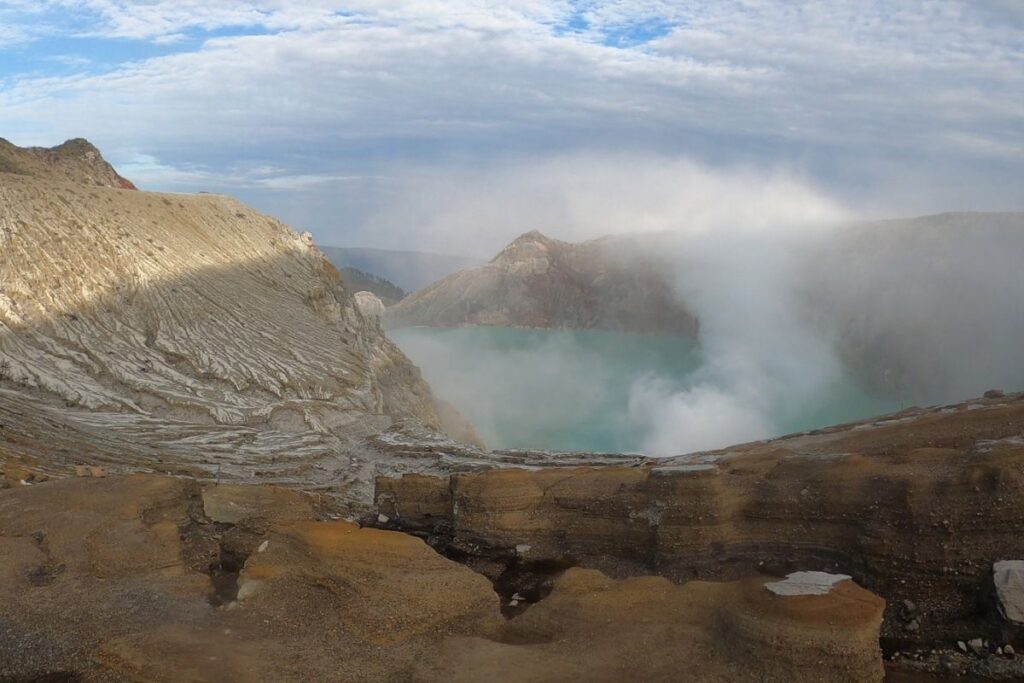
How Hard Is the Hike to Ijen Crater?
The difficulty of the hike to Ijen Crater can vary depending on your fitness level and hiking experience. It’s regarded as a moderately challenging hike, with steep sections and uneven terrain. The ascent will take around 1.5 to 2 hours, and it’s recommended to start early in the morning to avoid the midday heat.
The trek down can be more demanding due to the steep slopes, so caution is advised. It’s essential to be prepared physically and mentally, wear appropriate hiking gear, and follow safety guidelines to ensure a successful and enjoyable hike.
Is Ijen Crater Worth Visiting
Ijen Crater is worth visiting! The mesmerizing beauty of the crater lake and the unique natural phenomena make it a remarkable destination. The turquoise-colored acidic lake, surrounded by the dramatic volcanic landscape, offers a breathtaking sight.
Witnessing the blue fire phenomenon caused by ignited sulfuric gases is a rare and extraordinary experience. The cultural aspect of sulfur mining by local workers adds another layer of intrigue.
Why Does Mount Ijen Have Blue Lava
Mount Ijen does not have blue lava, but it exhibits a phenomenon known as blue fire. The blue fire is caused by the combustion of sulfuric gases escaping from the volcano’s vents.
Deep within the crater, molten sulfuric lava flows, heating the surrounding rocks. As the sulfuric gases rise and come into contact with the oxygen-rich air, they ignite and produce a mesmerizing blue flame.
The high temperature of the combustion, combined with the sulfuric compounds, creates this ethereal glow. It’s a unique and captivating natural phenomenon that sets Mount Ijen apart and attracts visitors from around the world to witness its beauty.
Hiking Indonesia’s Mount Ijen Volcano: Conclusion
Hiking Mount Ijen was truly a captivating experience. You won’t have any issues reaching the crater lake as long as you’re relatively fit. The sunrise we witnessed and the breathtaking panoramic views have made Ijen National Park a place that will forever stay in our hearts.
While most people will visit to hike Mount Ijen Volcano, don’t forget about Ijen’s surrounding National Park. It’s a sanctuary for both the soul and the environment.
Ijen National Park offers a remarkable blend of natural beauty, geological marvels, and cultural significance. It’s a must-visit destination for adventurers, nature lovers, and those seeking a deeper understanding of the world’s wonders.
Karee Blunt is a nationally syndicated travel journalist, focused on discovering destinations and experiences that captivate and inspire others through her writing. She is also the founder of Our Woven Journey, a travel site focused on inspiring others to create memory-making adventures with their loved ones. Karee is passionate about encouraging others to step out of their comfort zone and live the life they dream of. She is the mother of six kids, including four through adoption, and lives with her family in the Pacific Northwest. You can learn more about Karee on her about me page.
